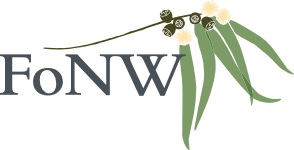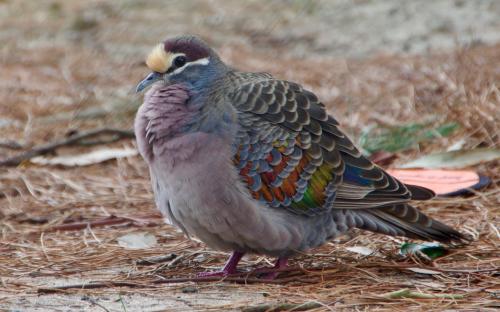Conservation status: of least concern.
What do they look like?
The Common Bronzewing is a medium-sized, heavily built pigeon. Their plumage ranges from grey, to dull brown, and they have a distinct white line that runs around and under each of their eyes. The males also have white or pale yellow forehead and a pinkish breast. The most iconic characteristic of the Bronzewing is the patches of iridescent colour on their wings, ranging from green, blue, red, gold and bronze. This colouring is what led to their name.
The Bronzewing pigeon can be told apart from other small doves and pigeons by the shiny, iridescent colouring of their wings. This may lead to them being confused with the common Crested Pigeon, as they also have some iridescent feathers on their wings. Bronzewings however, are missing the single spiked feather crest on the head, characteristic of the Crested Pigeon.
Habitat and diet
Bronzewings are hardy birds that can be found in most habitat types around Australia, with the exception of particularly barren deserts and dense rainforest. This can include biomes such as forests, grasslands, shrublands and heathlands. In more urban settings they can also be sighted in yards and parks where there is ample food and water supply.
They are most commonly sighted near bodies of water as they need to drink frequently. Bronzewings primarily feed on the seeds of native plants such as wattles and the Ruby Saltbush. Over the years they have also adapted to feed on the seeds of non-native species such as wheat and tree lucerne.
They spend much of their time on the ground where they feed, and are most commonly sighted alone or in small groups. They also build their nests closer the ground, low down in trees and bushes.
Where to find them in Bayside
Despite often being referred to as one of Australia’s most common pigeons (as its name would also suggest), the Common Bronzewing has become increasingly rare in the Bayside area due to habitat destruction and fragmentation. They can however, still be sighted in parks and heathlands where there is abundant native flora such as:
• Cheltenham Park
• Long Hollow Heathland
• George Street Heathland
What to listen out for
Their call is a low and rhythmical “ooom” sound. You can listen to it here.
Threats
The primary threat to the Common Bronzewing is loss of habit and habitat fragmentation that is caused by urban development. The loss of low growing native shrubs and natural water sources are particularly damaging to their survival.
In recent years, Friends of Native Wildlife Inc has run a number of community planting days, planting food trees and shrubs to improve Bronzewing habitat and encourage their numbers to increase in Bayside. This has included locations such as the former Sandringham Golf Driving Range, George Street (near Wangara Road) in Sandringham.
You can help
What can you do to encourage Bronzewings to visit your yard? Plant their favourite food, the Ruby Saltbush, and have a consistent water supply in a suitable bird bath. Help us determine whether the Bayside population is increasing by reporting your sightings at: https://www.bayfonw.org.au/sighting-report.
Did you know?
• Besides the Common Bronzewing, there are there two other bronzewing pigeons that fall under the “phaps” genus: the Flock Bronzewing (Phaps histrionica), and the Brush Bronzewing (Phaps elegans)
• Bronzewings are a particularly shy bird, and will fly off with a loud clattering sound when approached or startled.
Download our factsheet
FoNW Factsheet - Common Bronzewing
References and Further Reading
https://www.birdsinbackyards.net/species/Phaps-chalcoptera
https://animalia.bio/common-bronzewing
https://www.bayside.vic.gov.au/sites/default/files/2021-09/banksia_bulletin_-_winter_2017.pdf pages 12-13
https://www.reptilepark.com.au/common-bronzewing/
Credits
Author: Nykita Ivanoff
Photo: Denis Young

